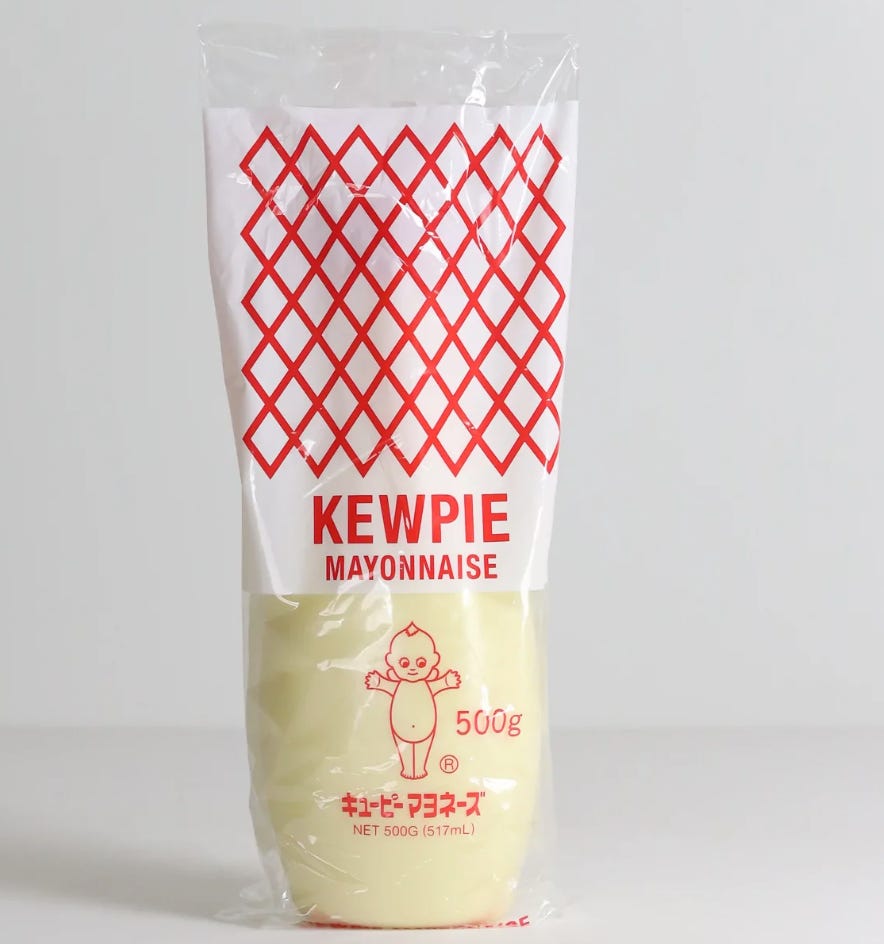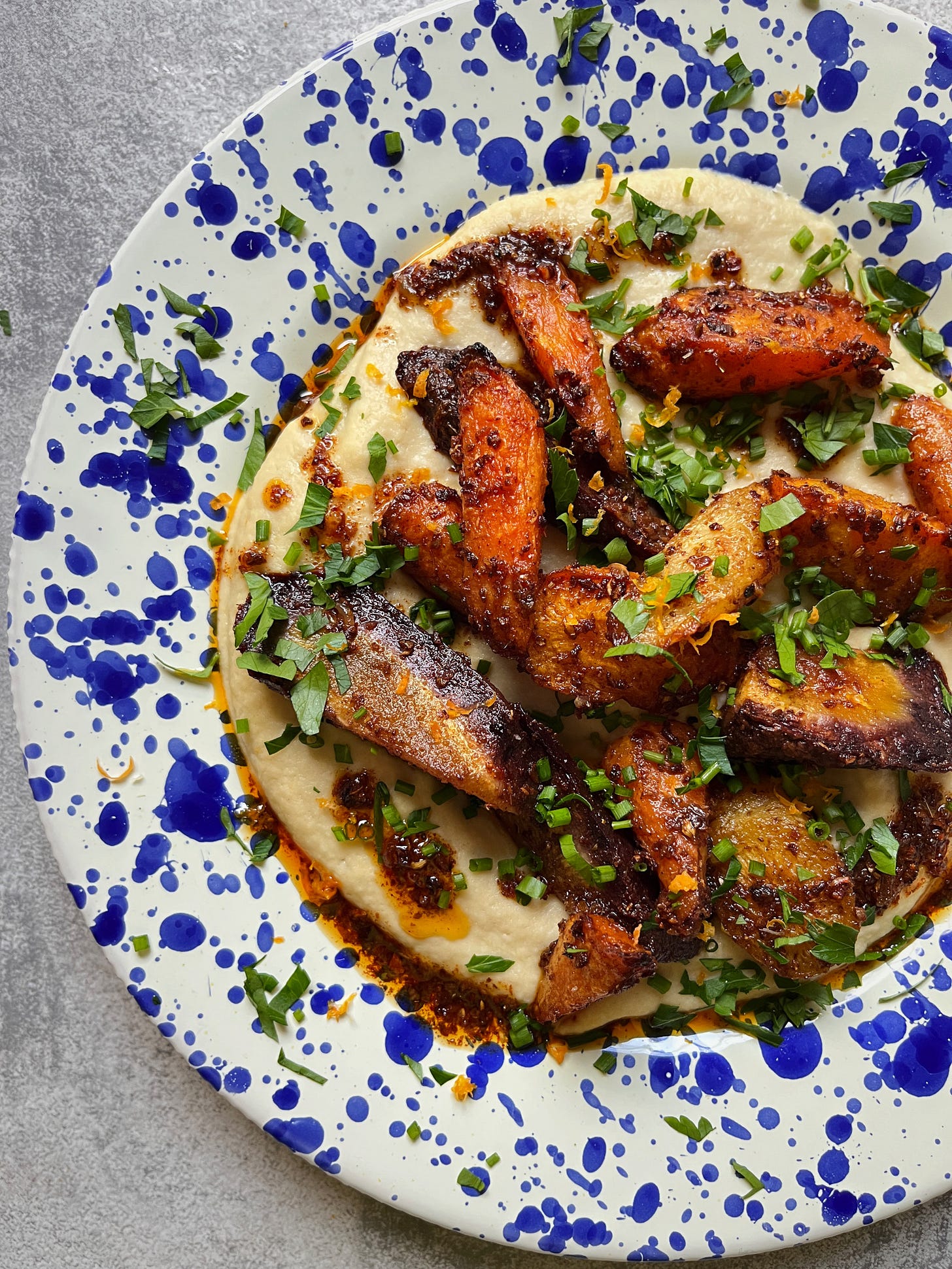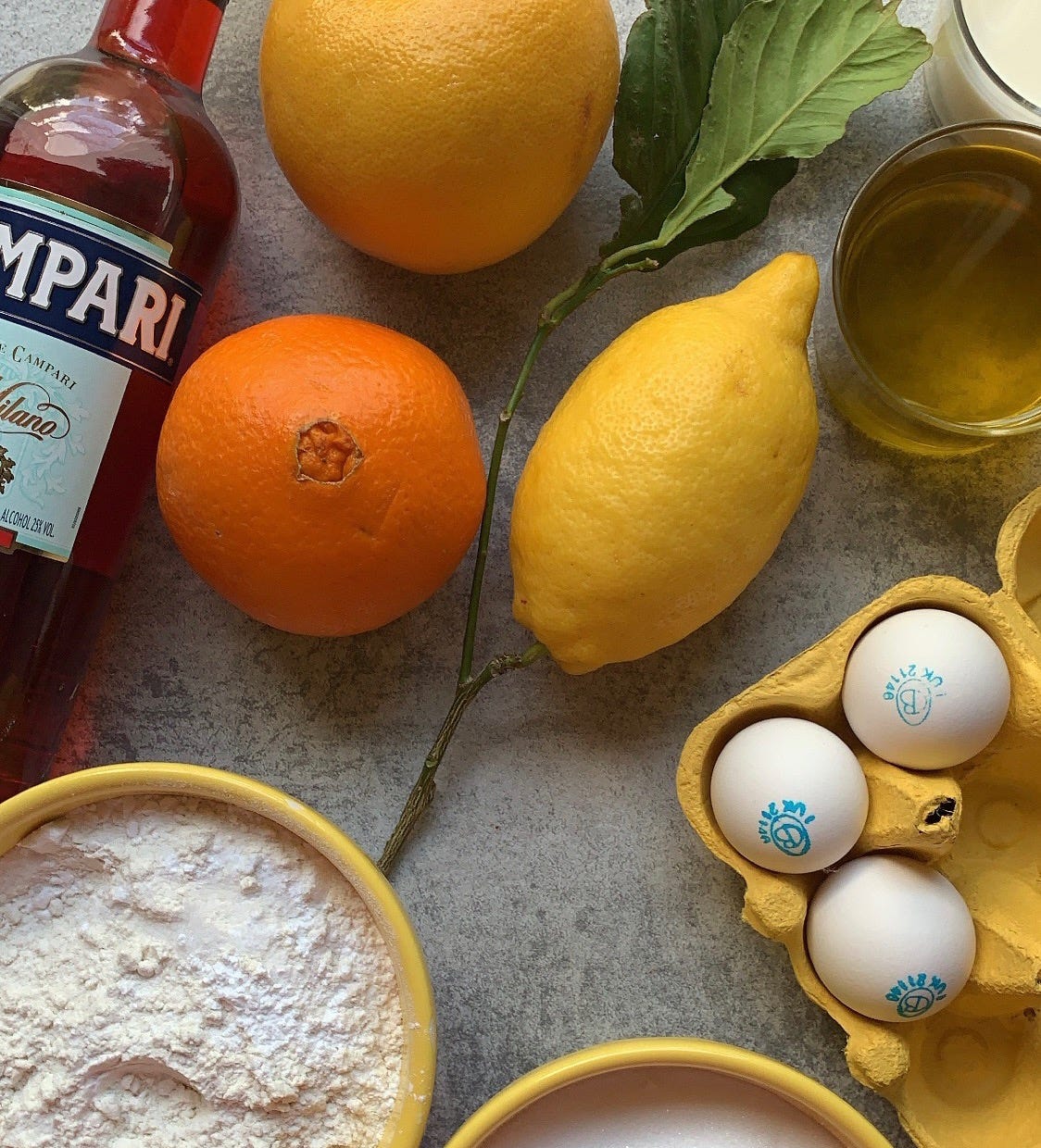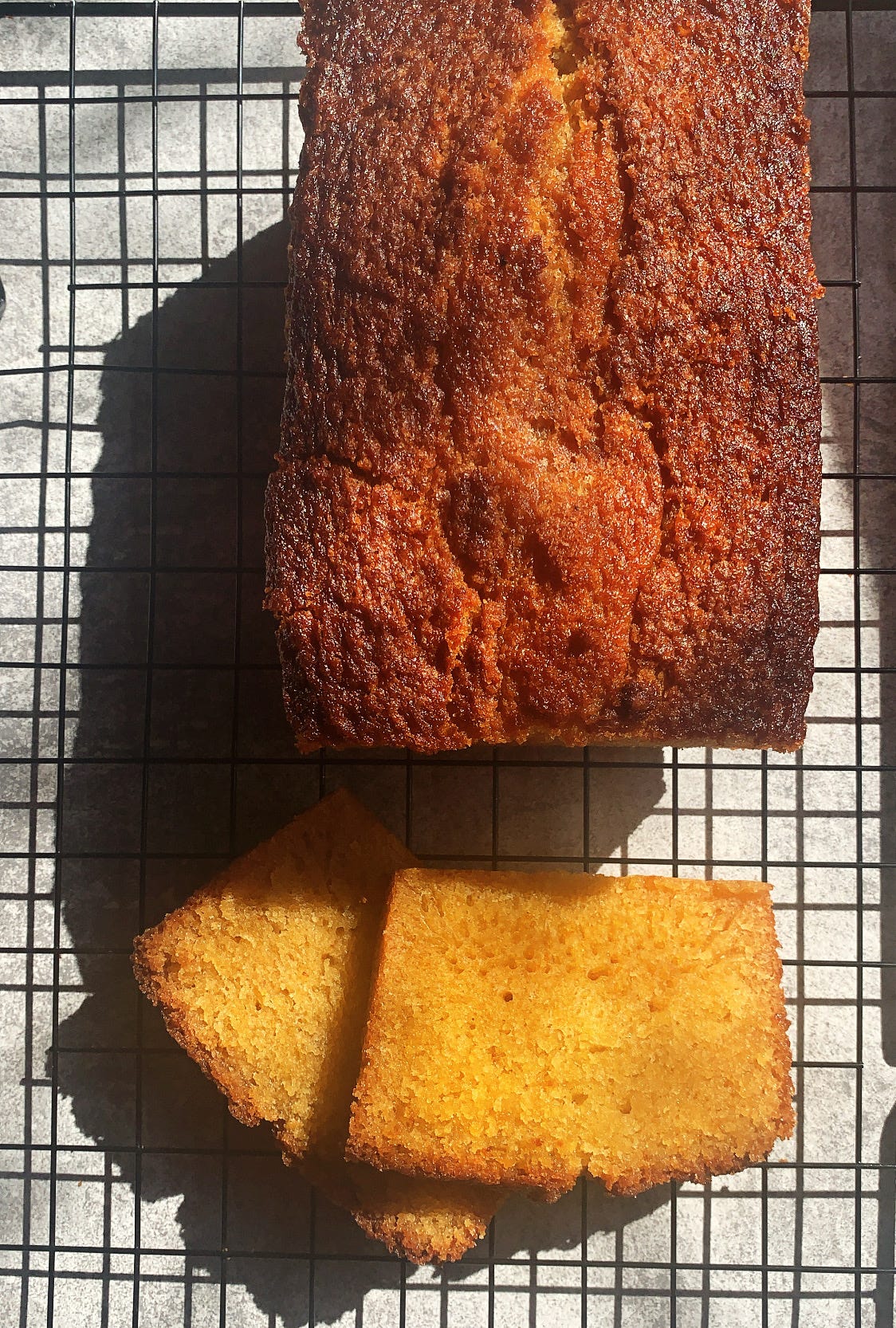What I’m currently consuming
The Condiment: Kewpie Mayonnaise
Ever since I first started working in food, I feel like those who know have been whispering about the magic Japanese mayo in the squidgy bottle. Not one to be particularly fussed by mayonnaise and never having seen it in shops, I ignored the whispers. But now I think the world has caught on, and I’m beginning to see this distinctive welcoming baby figure (Google tells me Kewpie was originally a brand of cute dolls) on many more shelves around London.
So what’s the fuss about? This mayo, made with egg yolks and a blend of cider and malt vinegar, has all the creamy, velvety satisfaction you look for in shop-bought mayo, but it’s somehow simultaneously rich and light, sweet and savoury, with a perky tang that makes it go PINGGGG in your mouth. I urge you to add it to your condiment collection without delay.
The TV Show: The Bear
I’m a little late to the party as people have been discussing this show for a few months now. It seems that, along with the The Menu (which many are blaming for the recent announcement of Noma’s closing) and Boiling Point (shot in one take, extremely anxiety-inducing), there is a fascination with kitchen-based drama. The Bear really delivers on the drama. And unlike the other two, it is actually worth watching - you really feel like you’re in the kitchen with them.
It follows Carmy, a young chef from a fine-dining background, as he takes over his late brother’s sandwich joint in Chicago that is much loved by regulars, but in a very sorry state in all other ways. A dirty, battered kitchen and recalcitrant staff are the least of his worries compared to his brother’s neglect of the business itself. It’s a 10/10 from me in every department: acting, script, direction and most of all the depiction of cooking (Boiling Point’s fatal flaw) and kitchen dynamics is beautifully accurate. Episode seven shot in one take is a masterpiece.
The Dip Tip: Ice Cubes
How do you houmous (or hummus?) Because I know you do. Ever met someone who doesn’t like it? Me neither. It’s so delicious, it’s hard to believe it’s so good for you. But I’m here to talk about making it. I tend to never buy it - it’s so quick and a shop-bought version can’t come close to tasting as good as a homemade one. Plus it’s significantly cheaper, especially if you cook your own chickpeas.
Its ratio of ingredients (and how it’s served) differs from region to region. Up until a few weeks ago, I used to be a die-hard believer in the olive oil-rich style. But then I discovered the Israeli version that leans heavily on tahini and use very little - if any - olive oil and is spectacularly silky and fluffy. The recipe, below, is this style.
But to my point…ice cubes! They are the key to fluffiness. Ice aerates the mixture as it blends, which, combined with at least 4-5 minutes (to incorporate as much air as possible) in the food processor or blender, gets you on the express train to smooooth. This can also be achieved by blending your chickpeas while still warm (see this great article), but if you’re whizzing from a jar or a tin, I strongly implore you to throw in a big handful of ice cubes and thank me later.
Something to fill you up
Warm Houmous with Shawarma Roast Carrots
Carrots love being surrounded by spices so I’m giving them a punchy combination usually reserved for the grilled kebab we know and love. A squeeze of juicy roast tangerine at the end lightens and brightens the flavour and adds an all-important acidity. I like to eat these spooned over warm houmous with some fluffy pita. If you haven’t tried the ice-cube-in-your-houmous trick yet (see above), have a go.
Eat this dish on its own or serve it as part of a Middle Eastern feast with some tabbouleh, a fattoush salad, grilled meat and pickles.
See my how to video here.
Serves 4
For the carrots
1 tsp coriander seeds
1 tsp cumin seeds
1 tsp pul biber or a pinch of chilli flakes
1 garlic clove
1 tsp sweet paprika
½ tsp cinnamon
3 tbsp olive oil
800g carrots, peeled and cut into 4-5cm chunks
1 tangerine, halved
For the warm houmous
600g jar of chickpeas, drained
70g tahini
1 garlic clove, chopped
Juice of 1 lemon
4 tbsp olive oil
6 ice cubes plus a splash of water
Parsley, chives, and/or mint, to serve
Zest of 1 tangerine, to serve
Warm pita, to serve
Preheat the oven to 200C/180C fan/gas 6 and line a large baking tray. Bash together the coriander, cumin and pul biber in a pestle and mortar or spice grinder, then bash in the garlic and the rest of the spices. Stir in the oil and season generously.
Toss the carrots in the shawarma oil and spread out on the baking tray. Add the tangerine halves to the tray and place in the oven for 25-30 minutes until the carrots are crispy on the edges and tender in the middle. As soon as the tray comes out the oven, squeeze over the roasted tangerine so the carrots suck up all its juice.
Meanwhile, throw the houmous ingredients and some seasoning into a blender and blitz until smooth. Check the seasoning, then transfer to a pan and gently warm up over a medium heat.
Spoon the houmous between plates or bowls and top with the carrots and any leftover pan oils. Sprinkle with some chopped herbs and zest over some tangerine before scooping up with some warm pita.
Something to finish you off
Campari, Citrus & Olive Oil Cake
As we approach peak citrus season, this cake by the clever Melissa Clark feels like the right way to celebrate it. It’s your classic tea cake, so no icing, just perky citrus juice, fragrant zest and a bittersweet whack from Campari holding your interest. Bringing this together is the savoury richness of olive oil.
It packs a really nice fluffy crumb, the holy grail when it comes to tea cakes. AND it’s ridiculously easy, just mix your dry ingredients into your wet and pop it into the oven.
By Melissa Clark
Serves 8-10
250g plain flour
340g caster sugar
1 tsp fine salt
1 tsp baking powder
½ tsp bicarbonate of soda
150ml whole milk
150ml mild olive oil
3 large eggs
80ml Campari
1 tbsp grapefruit zest
1 tbsp orange zest
1 tbsp lemon zest
60ml fresh grapefruit juice
30ml fresh orange juice
15ml fresh lemon juice
55g unsalted butter, melted
Preheat the oven to 180C/160C fan/gas 4. Line the bottom and sides of a 21cm/900g loaf tin or 23cm cake tin with greaseproof.
Combine the dry ingredients in a bowl. In another large bowl, whisk together the milk, oil, eggs, Campari, citrus zests, and citrus juices. Stir 3 tablespoons of this mix into the melted butter so it’s the same temperature, then reunite with the rest of the wet mix.
Fold in the dry ingredients, then transfer the mix into the lined tin.
Place in the middle of the oven for 50 minutes -1 hour (you may need to cover the top with some greaseproof if it begins to darken early on) until the top is golden and an inserted skewer comes out clean.
Allow the cake to cool in the tin, then run a butter knife around the edges to release the sides. Serve with crème fraiche, yoghurt or cream or eat on its own with a cup of tea.
My 10 Culinary Predictions for 2023
Set menus. With costs going up, restaurants will be be trying to hone their offerings and this is the most efficient way to avoid wastage and keep costs down.
Diversification of restaurants. Following on from the above point, restauranteurs will be diversifying their spaces so they can maximise their site, adding bakeries and delis to cater to a wider range of customers.
High-end tinned fish. Sardines, anchovies and mackerel are hitting a restaurant menu near you, maybe even still in their tin for extra boujee points.
We’ll be saying a fond farewell to fine dining. Where Noma goes, others follow. Neighbourhood restaurants will thrive.
Small plates will die a slow, painful death. The table is never big enough to fit your order and I’m tired of trying to halve a single arancini/croquette/dumpling.
More takeaway and cook-at-home kit businesses as people seek treats but don’t want to risk a full restaurant bill including wine and service charge.
The wave of multi-ethnic, borderless cuisine that embrace one person’s unique identity such as Thai LA Diner, Chet’s and Dai Chi, a Japanese-inspired modern American restaurant.
Regional-specific pizza bases. We’ve had Roman, we’ve had Neopolitan and now’s the moment for New York-style slices and Chicago-style deep dish.
More vegetables and pulses and less meat and fish on menus. At middle-priced restaurants, the meat and fish we see will be cheaper varieties and cuts such as skate, bavette, pork cheeks.
Even MORE fermented foods as chefs get (even more) clever and experimental with their ingredients. Our gut microbiomes are quietly rejoicing…















